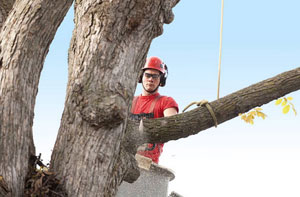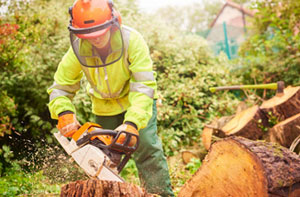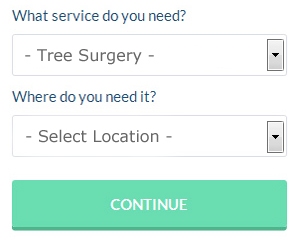Livingston Tree Surgeon Scotland: Adding substance, style and structure to what can often be a two dimensional area, trees are a crucial feature of properties and gardens in Livingston. This is all well and good, but when trees are poorly maintained, diseased, or impacted by extreme weather events, for example flooding or storms, problems can develop that will need to be addressed. If your trees need attention, it's the safest option to consult an established tree surgeon in Livingston, for their expert advice prior to any work starting.
Those who hire non-qualified personnel, or try to do tree work for themselves, may cause a risk of damage to the trees, to property and to life. But even employing a skilled tree surgeon who is aware of all the hazards does not mean that tree work is safe. The reality is that tree surgery is one of the most hazardous jobs in the UK, with an average of three deaths and 140 severe injuries per year within the profession, therefore it's definitely not safe work for amateurs.

A damaged or neglected tree can also cause a danger to life, with around five people a year being killed by falling branches or trees in Britain. You could be liable to third-party compensation claims as a consequence of your actions, if you hire someone to do tree work and there is an injury, or damage to property. This is why employing a qualified Livingston tree surgeon to carry out the work on your trees is very important. (The figures given were sourced from HSE UK).
PICKING A TREE SURGEON IN LIVINGSTON - There are 2 major industry bodies, one or both of which a seasoned Livingston tree surgeon should be an approved member of. You can check out the professional standing and membership of any tree surgeon in Livingston on the websites of either the Arboricultural Association (AA) or the International Society of Arboriculture (ISA). On this webpage you can check for membership of either of these associations, which gives the tree surgeon in question, ARB Approved Contractor status.
If there's a problem during or after any tree work has been carried out you are able to get hold of these professional organisations for arbitration assistance and for advice and help at any point.

If anybody who you cannot find on this directory offers to provide you with a price quote, you should graciously decline their offer of work and continue your search for an accredited contractor. Once you're reassured of their qualifications and professional associations you should try and get a minimum of 3 quotes from different companies in the Livingston area. Because of the risks involved in the work, you should ask the questions below, making it abundantly clear that you need a response:
- What insurance cover is provided? As suggested by the AA and ISA, your tree surgeon ought to be able to produce a certificate covering at least five million pounds public liability insurance.
- Can I inspect the quality of your tree work by contacting a person you've recently worked for? It's generally advisable to perform an independent check on recently completed work.
- Can you provide documents to demonstrate that you have the recommended qualifications, membership of the ISA or AA, and also a certificate for basic chainsaw use from the NPTC? The NPTC/LANTRA is a required certificate in law for any worker/tree surgeon using a chainsaw. A competent tree surgeon in Livingston will possibly hold Certificates and National Diplomas in Arboriculture.
- Can you provide me with a quotation in writing? Verbal quotes alone are not sufficient. Always get a quote in writing.
On the written quote that you receive, you will need there to be clear and accurate specifics of all the work that's being undertaken. It should indicate who's responsible for the removal of waste, tree branches and stumps, and should also include information on any trees which may be protected, and the steps required to get permission to carry out work on them. Double check that VAT has also been included on the quote. You've got a responsibility for employing only qualified people to work on your trees and property, and it is important to understand that.
PRIOR TO WORK BEGINNING - Your preferred Livingston tree surgeon should make enquiries into the possibility of any trees being protected in your area and make the necessary steps to make certain that any tree work can get the green light from the local authorities. Discovering that a tree has got protected status does not imply that work can't be carried out, since even protected trees need maintenance so as to cut back old or dying wood and ensure the safety of the public.
If your property in Livingston is inside a designated conservation area then no less than 6 weeks written notice must be given to the Local Planning Authority prior to any work being conducted. However, tree trunks of under 7.5cm in diameter when measured at 1.5 metres from ground level are free from this requirement. It's also not necessary to give notice if a protected tree's branches need thinning or pruning simply to sustain and promote growth.

Your chosen Livingston tree surgeon will decide on the required remedial treatment and how best and safely to achieve the required outcome after doing a full assessment of your trees health. Where there's any chance of falling branches and debris, a risk assessment will have to be undertaken on your property, public areas, and parts of neighbouring properties that may be affected. This stage will also determine the number of workers needed and the level of protection required. This is both personal protection equipment as well as other safety precautions to keep property and the general public safe from damage or harm.
ON THE DAY OF WORK - To keep unauthorised persons away from the work area, safety measures and barriers will be put in place before any cutting of branches, climbing or tree felling is started. Traffic may need to be temporarily halted if there is any threat of debris falling into a public highway.
The tree surgeon will need different degrees of protection subject to the type of tree work being undertaken. At the very least they will be wearing protective clothing to avoid cutting injuries to the hands, legs and torso, when working with a chainsaw. Head and eye protection, and high-vis clothing, must be worn by all operatives involved in the work.
Ladders and associated climbing equipment will need to be deployed if working at height is involved, and to help in the safe removal of high branches and sections of tree trunk, extra personnel will be necessary. A skip or other method of transporting the waste materials away will be stationed as close to the work area as possible, therefore it is advisable to inform your neighbours of the need for easy access.
AFTER COMPLETION OF WORK - The whole site can be cleared of all debris, and all the branches and waste can be transported away, when all tree work has been accomplished. Your tree surgeon should then prepare and sign off a certificate of work done, a copy of which will be handed to you. This is especially important where trees covered by a protection order are concerned. If there were any public spaces that required safety measures, this protection will be taken away and paths and highways will be re-opened to the public.
If you've got any problems or issues with the completed work, you should first address them with your tree surgeon so that they can be rectified immediately. If any further arbitration is required, and your tree surgeon is a member of a professional body, you can obtain help and guidance from the ISA or AA in order to arrive at a satisfactory solution.
Locally based Livingston tree surgeons will most likely have the phone code 01506 and the postcode EH53. They'll operate in Livingston itself, along with nearby areas like East Whitburn, Winchburgh, Uphall, Polbeth, Dechmont, Deans, Kirknewton, Seafield, Livingston Village, East Calder, Bathgate, Newbridge, Broxburn, Kirkton Campus, Bridgend, Pumpherston, and these postcodes: EH54 0TU, EH54 0JP, EH54 0SD, EH54 0JW, EH54 0SP, EH53 0TN, EH54 0SZ, EH54 0DU, EH54 5LB, EH54 0WZ.
For this type of service it's unquestionably better to use a trusted local tree surgeon. Livingston homeowners can benefit from the knowledge and skills offered by a seasoned professional.
Tree Stump Removal Livingston
If you are in a position where you need to have a large tree removed from your property in Livingston, you're possibly going to be stuck with a stump, which also needs to be tackled. In some cases it might be feasible for you to leave the tree stump in position until such time as it rots and breaks down by itself. However, a substantial tree stump could take several years to rot away, and may even produce new suckers in an effort to restore itself to its former glory. Protruding stumps can also attract undesirable pests, be a trip hazard, and be an eyesore.
If you decide to remove the stump totally, there are several ways to do this, however they fall under 2 key choices stump removal and stump grinding. For the purposes of this piece we'll be focusing on stump removal in Livingston as opposed to stump grinding.
Chemical treatment, burning or digging out by hand, are the 3 main methods of getting rid of a tree stump. If you're hoping to deal with a stump on your own, the use of any of these procedures could be possible. If you're using a tree surgeon in Livingston, they will normally recommend the aforementioned stump grinding option.
Chemical Stump Removal: A strong chemical like Roundup Tree Stump Remover, Vitax SBK Stump Killer or Resolva Xtra Tough Tree Stump Killer, will be needed if you opt to go down the chemical treatment route. Always wear gloves and avoid skin contact when utilising any of these chemical solutions, and also avoid inhaling. You must stick rigidly to the maker's instructions, for rates, applications and timings. This should be seen as a long term stump removal solution, as it may take quite a few weeks or even months to rot away, depending on the size of the stump. It will still have to be removed with a spade and an axe once it has rotted completely.
Stump Digging: Digging out a stump by hand calls for an assortment of tools such as a handsaw, a pointed shovel, a chainsaw and loppers. It involves digging down to uncover the roots, cutting the roots with a saw or loppers, and eventually freeing the stump, or making it easier to lift out. Some sort of cable ratchet winch could be needed for the final freeing process. This tends to be laborious and tiring work, and should never be tackled by anyone who isn't fit and healthy.
Tree Stump Removal by Burning: Be careful if you use this approach to stump removal, since stump burning can be fairly dangerous and might be at variance with local laws. The burning procedure involves drilling out several holes in the tree stump, filling keeping them topped up with vegetable oil over a period of several days until saturated. You should then cover the tree stump with charcoal or logs and set fire to it. You or somebody will need to continually supervise this until the fire has died down. When the fire has burnt out, you need to make certain that it's fully extinguished and cool, after which you will be able to manually dig out the burnt stump remains and roots.
This is not the only way to burn a tree stump, you could also try scooping out all the soil from under the stump and setting a fire in the cavity that's been created beneath. None of these burning techniques should ever be used if the stump is in close proximity to other trees, a building or fences.
Tree Transplanting Livingston

Removing mature trees and transplanting them in a new location may sound difficult, but with heavy lifting equipment and truck mounted tree spades, it has become a fairly straightforward undertaking. A competent tree moving contractor in Livingston will be happy to move any trees you have on your property, or transplant fully developed trees for an instant aesthetic appeal.
Moving a tree in Livingston is less stressful on the root system and wellbeing of the tree in the winter and autumn, but it can still be achieved during the warmer months by soaking the soil thoroughly before lifting. Moving an adult tree will involve a mechanical spade burrowing down and encircling the main root-ball, before raising the entire tree, unharmed, from the soil. The uplifted tree can then be stored temporarily before its transplanting in its new home.
If you wish to move a tree from ground that's got a preservation order on it, a specialist tree moving contractor in Livingston can collaborate with relevant agencies to approve transplanting in an agreed location. You'll be able to obtain tree transplanting specialists in East Whitburn, Winchburgh, Uphall, Polbeth, Dechmont, Deans, Kirknewton, Seafield, Livingston Village, East Calder, Bathgate, Newbridge, Broxburn, Kirkton Campus, Bridgend, Pumpherston, and the Livingston area.
Regular Tasks for a Tree Surgeon
- Prepare tree survey reports for domestic and commercial clients.
- Be proficient with power tools and other powered machinery.
- Maintain and service equipment like wood chippers and chainsaws.
- Fell and remove trees and perform stump grinding.
- Assess tree health and treatment.
- Clean up site upon completion and remove waste products from customer's site.
- Tree planting and transplanting.
- Deal with clients and complete administration duties.
- Prepare on-site or telephone price quotes with the clients.
- Cut and chip logs and branches.
- Climb trees to remove or prune branches as required.
- Establish dangers presented by trees.
Tree Removal Livingston

If your tree is in the way of new development, your tree presents a safety risk, the roots of a tree are damaging retaining walls/foundations, your tree has been uprooted by the weather, the tree has grown too large, your tree is diseased/infected or you have a dying/dead tree, then you've likely got a bona fide reason for tree removal. Otherwise the removal of a tree should in fact be the last resort, as trees are in general a beautiful and beneficial addition to your garden. Quite a few householders in Livingston would like to take out a tree or trees to gain a better view or to avoid nuisance from leaves in winter time, this is less imperative and ought to only take place in extreme cases.
Problems With Tree Roots Livingston

Because some trees have particularly aggressive roots, if they're growing too near to your home in Livingston, they can lead to various issues, potentially serious ones. Among the most common issues are: lifting patios, blocked drains and damaged foundations. Extremely intrusive roots are found in species like willows, elms, maples and sycamores.
Keeping any new trees you plant on your property, as far as possible away from patio areas, pathways, your sewerage pipes and your house, is recommended to avoid future issues. If you already have problems with established trees which are growing too close to your dwelling, you can get guidance and advice by contacting a local Livingston tree surgeon.
You should not try and deal with this yourself by just hacking away at the problematic roots, because this could significantly threaten the tree's health or even kill it in some cases. To successfully survive, a tree will still need to be getting sufficient nutrients and water, and a seasoned tree surgeon in Livingston will know which roots can be cut, and which roots should be left in place.
Shrub and tree roots regularly cause cracks in underground drains, since sewer lines provide a continuous source of water and nutrients. Joint failure and even blockages can occur, when minute roots grow into the joints of a drainage system, establish themselves and grow into sizeable root balls. High quality root removal solutions will be provided by some Livingston tree surgeons, who will employ high pressure water jetting, mechanical equipment or manual rodding to eradicate the troublesome roots. (Tags: Tree Root Problems Livingston, Problematic Tree Roots Livingston, Drain Root Removal Livingston, Invasive Tree Roots Livingston).
Tree Surgery Accidents
As has been stated previously in this article, the work that is done by tree surgeons in Livingston can be very hazardous. All possible safety measures should be taken when carrying out work on trees, because most tree work involves a considerable risk of injury to both operatives, co-workers and passers-by.
A large majority of fatal and major injuries are associated with the use of chainsaws, falls from trees, and being hit by a falling branch or tree, according to the Health & Safety Executive (HSE). The reality is that people working in tree care have a greater chance of serious injury than those in building and construction.
In relation to insurance claims the most common tree work accidents involve slipping from ladders, lifting injuries and being struck by objects (cranes, ropes, branches, grapple hooks, trees etc).
When work needs to be done on your trees, all this emphasises the importance of choosing a knowledgeable Livingston tree surgeon. Unskilled workers trying to tackle tasks that they haven't been trained to do, accounts for the majority of accidents in the tree care industry. Therefore, try to always use an established and trustworthy company which has been operating in the Livingston area for several years, to avoid this type of problem.
The International Society of Arboriculture
The ISA (International Society of Arboriculture) is a non-profit, international organisation that is based in Georgia, USA, with the aim of fostering the awareness and benefits of trees. Serving the tree care industry all around the globe, the ISA is a membership association that champions the professional practice of arboriculture, providing credentials for tree care professionals.
With its focus clearly on research, education and technology, the ISA encourages best tree care practice through educational publications, events and services, enabling those who work in the tree care sector to improve their knowledge, arboricultural expertise and skills.
Since an agreement was signed in 2016 the Arboricultural Association has been an associate organisation of the International Society of Arboriculture. Providing additional opportunities for ISA members in the UK and Ireland, this also substantially strengthened the relationship between the 2. Arboricultural Association members in the UK and Ireland now benefit from being part of an international network of tree care professionals. Boasting over twenty two thousand members globally the ISA now has associate organisations and professional affiliates in EXTRAtree lightening protection Livingston, felling of storm damaged trees in Livingston, cabling, landscaping, stump grinding in Livingston, damage restoration, site clearance in Livingston, health inspections, hedge reduction, woodland clearance, tree lopping Livingston, crown thinning, forestry management Livingston, fruit tree pruning, hazard assessments, tree maintenance Livingston, tree waste removal Livingston, eco-plugging in Livingston, tree watering, root pruning Livingston, emergency tree surgery, tree dismantling Livingston, crown reduction in Livingston, tree topping in Livingston, vegetation management, root grinding, tree replanting Livingston, crown cleaning in Livingston, commercial tree surgery, drop crotching in LivingstonTEN, and the United Kingdom.
Tree Surgery Tasks Livingston

Livingston tree surgeons can usually help with tree lightening protection Livingston, felling of storm damaged trees in Livingston, cabling, landscaping, stump grinding in Livingston, damage restoration, site clearance in Livingston, health inspections, hedge reduction, woodland clearance, tree lopping Livingston, crown thinning, forestry management Livingston, fruit tree pruning, hazard assessments, tree maintenance Livingston, tree waste removal Livingston, eco-plugging in Livingston, tree watering, root pruning Livingston, emergency tree surgery, tree dismantling Livingston, crown reduction in Livingston, tree topping in Livingston, vegetation management, root grinding, tree replanting Livingston, crown cleaning in Livingston, commercial tree surgery, drop crotching in Livingston and other tree surgeon services in Livingston, Scotland. Listed are just some of the activities that are undertaken by a tree surgeon. Livingston providers will let you know their entire range of services.
Tree Surgeons Nearby
Also find: Pumpherston tree surgeon, Dechmont tree surgeon, Uphall tree surgeon, Winchburgh tree surgeon, Kirkton Campus tree surgeon, Polbeth tree surgeon, Deans tree surgeon, East Calder tree surgeon, Kirknewton tree surgeon, Seafield tree surgeon, Livingston Village tree surgeon and more. Pretty much all of these towns and areas are catered for by tree care companies. Home and business owners in these places can acquire price quotes for tree surgery by going here.
Tree Care Services Livingston
- Livingston Crown Thinning
- Livingston Stump Treatment
- Livingston Crown Lifting
- Livingston Root Grinding
- Livingston Stump Removal
- Livingston Tree Removal
- Livingston Tree Surveys
- Livingston Site Clearance
- Livingston Crown Reduction
- Livingston Tree Reduction
- Livingston Tree Lopping
- Livingston Root Removal
- Livingston Cable Bracing
- Livingston Tree Management
 Tree Surgeon Livingston
Tree Surgeon Livingston Tree Care Livingston
Tree Care Livingston Tree Surgery Livingston
Tree Surgery LivingstonFor local info on Livingston, Scotland look here
Tree Surgeon Jobs Livingston: Find Livingston tree surgeon jobs here: Tree Surgeon Jobs Livingston
Tree Surgery EH53 area, (dialling code 01506).
Tree Surgeons Livingston - Tree Surgeon Livingston - Tree Surgery Livingston - 01506 - Tree Felling Livingston - Crown Lifting Livingston - Woodland Management Livingston - Tree Management Livingston - EH53






